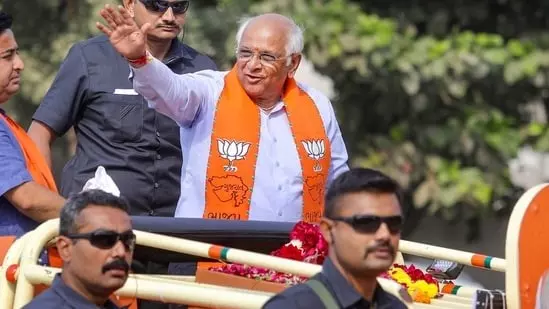
Gujarat: Why BJP is bending over backwards to keep Kadva Patels happy
The Patidar sub-community is both economically powerful and the largest caste-based vote bank in Gujarat; BJP is keen to keep this community on its side

The Patidars or Patels, who form 15 per cent of Gujarat’s electorate, have always held the key to who forms the government in the state.
So, it did not come as a surprise when many BJP leaders, including Gujarat CM Bhupendra Patel, attended an Umaiya Darbar, a kangaroo court held by Vishv Umiya Foundation (VUF), a body of Patidars in Ahmedabad.
Headquartered in Ahmedabad, the VUF works towards the economic, social and religious upliftment of the Patidars, also known as Patels, in Gujarat. The court based on the panchayat system model aims to resolve disputes or disagreements among the community members, rather than taking matters to judiciary, said a VUF member.
Social organisation
The VUF is a social organisation of Kadva Patidars, a sub-caste in the Patel community that has been the traditional vote bank of the BJP. The Patels are divided into two main sub-castes – Kadva and Leuva. Together, they form about 15-16 per cent of Gujarat’s electorate and hold influence in over 50 seats of the 182-member assembly.
North Gujarat is dominated by Kadva Patels, who form a majority in the state too, followed by Leuva Patels and then there are two smaller sub-castes in social hierarchy – the Chaudharys and Anjanas. While Kadvas are mostly businessmen dealing in diamonds and textiles, the Leuvas are not so financially strong and are primarily landowners and farmers.
Noticeably, most of the BJP leaders, like former CMs Keshubhai Patel and Anandiben Patel, and former state Finance Minister Sourav Patel, hail from the Leuva Patel sub-caste. Kadva Patels, though, have always been a vote bank for the party but never had significant political representation within the BJP or the government.
BJP's struggle
However, following the Patidar Anamat Andolan in 2016, led by Hardik Patel, a Kadva Patidar leader from north Gujarat, the BJP had been struggling to retain the Patel vote.
In a first, the Kadva Patidars have begun to move away from the BJP, disgruntled by the ruling party, and are demanding political representation for the community.
Manihi Jani, a Gujarat-based political analyst and activist, said the BJP had miscalculated the impact of Kadva Patidars during the polls of 2017 but quickly learnt from their mistake.
“They switched their loyalty, playing a crucial role in BJP’s tally getting reduced to 99 in 2017 state polls. Five years later, in the 2022 assembly polls, it was the Kadva Patidars among all the communities that ensured the BJP set a new record by breaching the 150-mark in Gujarat. After this, the party had learnt its lesson to never underestimate the electoral impact of Kadva Patels,” pointed out Jani.
Giving sops
Further, Jani pointed out that the first move that the BJP made that placated the community was giving 10 per cent quota in jobs and education to the poor (economically weaker sections or EWS) amongst the Patels.
“Then they brought in Bhupendra Patel, a Kadva Patidar with a background in business, who had also been on the board of several Kadva Patel community organisations like Sardar Dham and Vishwa Umiya Foundation. The party also reshuffled the Vijay Rupani cabinet to bring in more Patels. With Bhupendra Patel as the CM and Rushikesh Patel as the health minister, the Kadva Patidars got a representation in the government that they had been demanding,” he said.
However, even after a historic win in the Assembly polls, and winning back the Patels, the BJP is not leaving anything to chance.
Keeping Patidars happy
The first decision of the Bhupendra Patel-led BJP government after winning the 2022 polls was to give approval for a ₹18.25 crore grant for the development of Umiyadham, the place of worship of the Kadva Patidar community located in Jamnagar district.
In July that year, Rushikesh Patel raised a long-pending demand of the Kadva Patidars in the assembly session - the possibility of making parental consent mandatory in love marriages. Soon after, while addressing a public function of the Patidar community in Mehsana district, the CM said his government would look into the matter.
History of Patels’ support
The Patels have been the BJP’s traditional support base since the years 1984-85.
Before that, the Congress had a stronghold over north Gujarat until Madhavsinh Solanki regime. He was the chief minister of Gujarat four times and came to power in the 1980s by uniting the party vote bank under the theory of KHAM – Khastriya, Harijan, Adivasi and Muslim. This led other communities to lose political significance, one being the Patels, whose allegiance since then have been with the BJP.
Gautam Shah, a former professor and political analyst from Ahmedabad, sums up the power of the community: “You cannot win Gujarat without ensuring the support of Patels. Even with the AAP, which made inroads in the 2019 Gujarat local polls, it was largely due to the support of the Patidar dominated areas. The Patels, especially the Kadva Patidars, make a formidable vote bank as they are both economically powerful and are the largest caste-based vote bank in Gujarat.”

